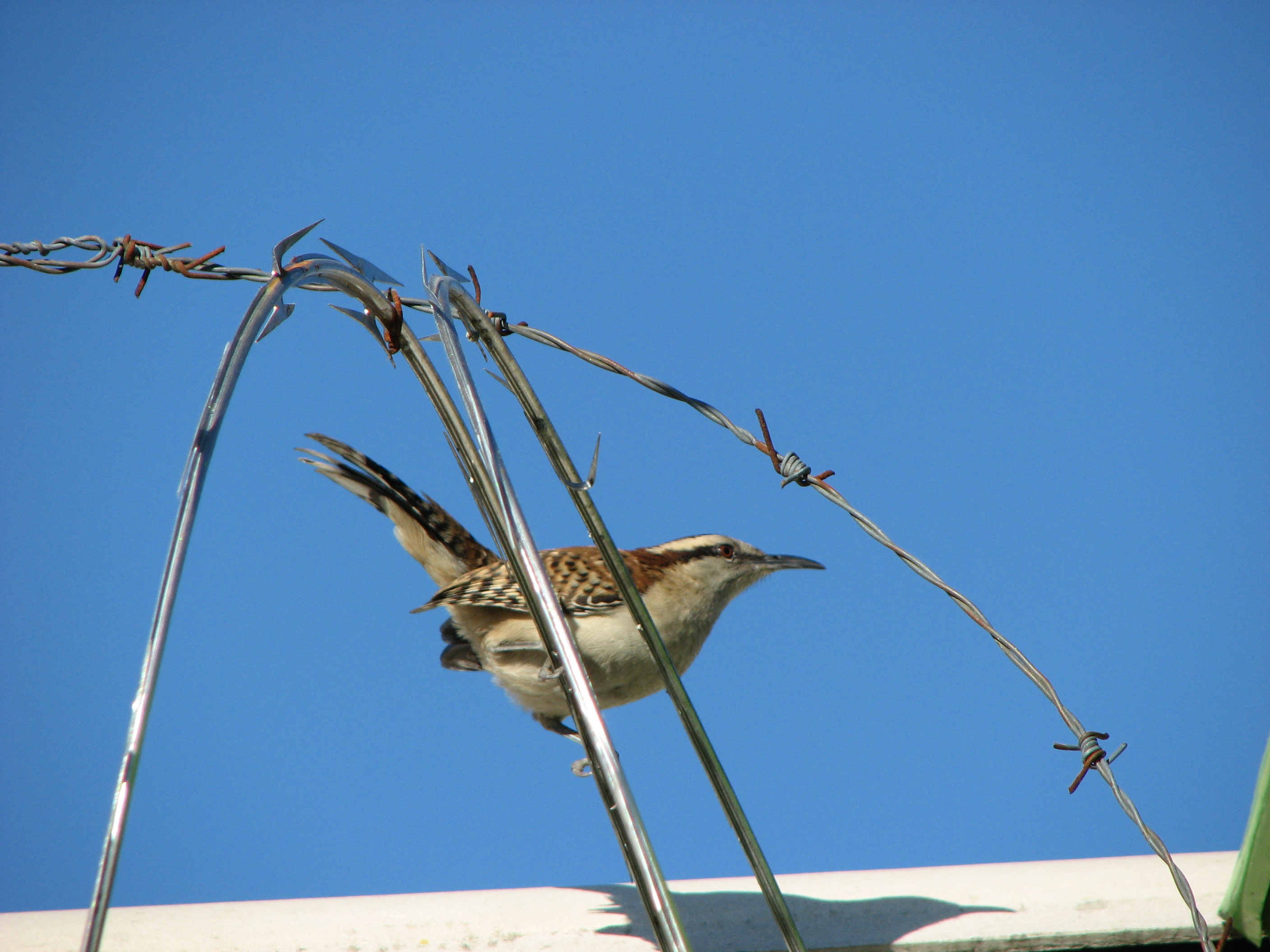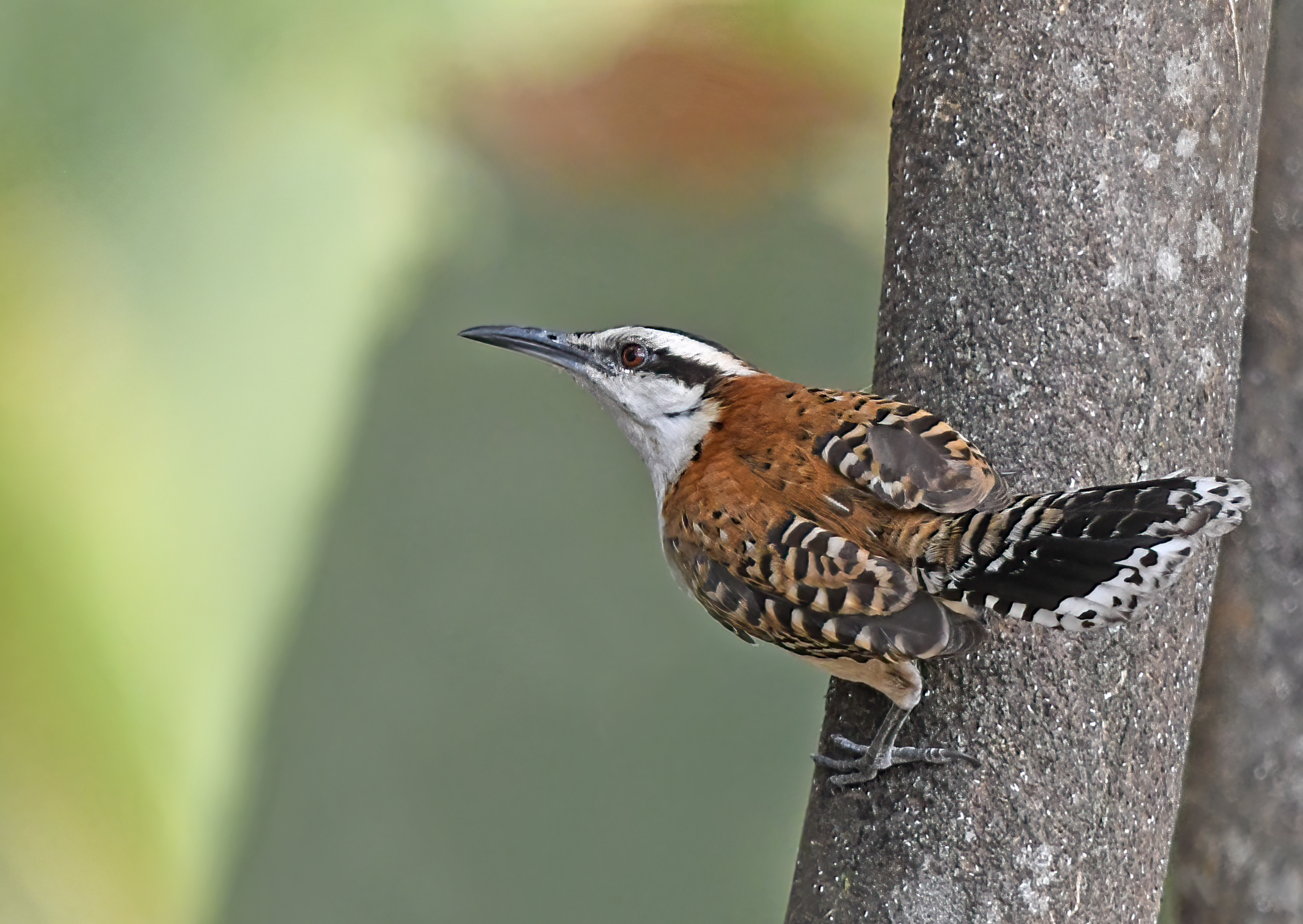Rufous-backed Wren on:
[Wikipedia]
[Google]
[Amazon]
The rufous-backed wren (''Campylorhynchus capistratus'') is a

 The adult rufous-backed wren is long and weighs . There is some variation among the subspecies but generally they have a black crown and eyestripe separated by a white
The adult rufous-backed wren is long and weighs . There is some variation among the subspecies but generally they have a black crown and eyestripe separated by a white 
One from Mexico i
Its calls have great variety even within each subspecies; examples includ
an
songbird
A songbird is a bird belonging to the suborder Passeri of the perching birds (Passeriformes). Another name that is sometimes seen as the scientific or vernacular name is Oscines, from Latin ''oscen'', "songbird". The Passeriformes contains 5,00 ...
of the family Troglodytidae. It is a resident breeding species from southwest Mexico
Mexico, officially the United Mexican States, is a country in North America. It is the northernmost country in Latin America, and borders the United States to the north, and Guatemala and Belize to the southeast; while having maritime boundar ...
to northwestern Costa Rica
Costa Rica, officially the Republic of Costa Rica, is a country in Central America. It borders Nicaragua to the north, the Caribbean Sea to the northeast, Panama to the southeast, and the Pacific Ocean to the southwest, as well as Maritime bo ...
.Bradley, D. W. and D. J. Mennill (2020). Rufous-naped Wren (''Campylorhynchus rufinucha''), version 1.0. In Birds of the World (T. S. Schulenberg, Editor). Cornell Lab of Ornithology, Ithaca, NY, USA. https://doi.org/10.2173/bow.runwre1.01 retrieved May 31, 2021
Taxonomy and systematics
What is now the rufous-backed wren was previously treated as six of the eight subspecies of rufous-naped wren (''Campylorhynchus rufinucha''). A 2009 publication proposed that ''Campylorhynchus rufinucha'' (''sensu lato
''Sensu'' is a Latin word meaning "in the sense of". It is used in a number of fields including biology, geology, linguistics, semiotics, and law. Commonly it refers to how strictly or loosely an expression is used in describing any particular co ...
'') be split into three species and the International Ornithological Committee
The International Ornithologists' Union (IOU) is an international organization for the promotion of ornithology. It links basic and applied research and nurtures education and outreach activities. Specifically, the IOU organizes and funds global co ...
(IOC) accepted the splits. What had been ''C. r. humilis'' was elevated to species status as Sclater's wren. The reduced ''C. rufinucha'' received the new English name Veracruz wren and the other six subspecies became subspecies of rufous-backed wren.
BirdLife International
BirdLife International is a global partnership of non-governmental organizations that strives to conserve birds and their habitats. BirdLife International's priorities include preventing extinction of bird species, identifying and safeguarding i ...
(BLI) has implemented the split but retains the English name rufous-naped wren for ''C. rufinucha''. However, the North American Classification Committee of the American Ornithological Society
The American Ornithological Society (AOS) is an ornithological organization based in the United States. The society was formed in October 2016 by the merger of the American Ornithologists' Union (AOU) and the Cooper Ornithological Society. Its ...
(NACC/AOS) and the Clements taxonomy
''The Clements Checklist of Birds of the World'' is a book by Jim Clements which presents a list of the bird species of the world.
The most recent printed version is the sixth edition (2007), but has been updated yearly, the last version in 202 ...
have not accepted the split as of early 2021.Clements, J. F., T. S. Schulenberg, M. J. Iliff, S. M. Billerman, T. A. Fredericks, B. L. Sullivan, and C. L. Wood. 2019. The eBird/Clements Checklist of Birds of the World: v2019. Downloaded from https://www.birds.cornell.edu/clementschecklist/download/ Retrieved August 15, 2019
The six subspecies of rufous-backed wren accepted by the IOC are:
*''C. c. nigricaudatus'' Nelson
Nelson may refer to:
Arts and entertainment
* ''Nelson'' (1918 film), a historical film directed by Maurice Elvey
* ''Nelson'' (1926 film), a historical film directed by Walter Summers
* ''Nelson'' (opera), an opera by Lennox Berkeley to a lib ...
(1897)
*''C. c. capistratus'' Lesson
A lesson or class is a structured period of time where learning is intended to occur. It involves one or more students (also called pupils or learners in some circumstances) being taught by a teacher or instructor. A lesson may be either one ...
(1842)
*''C. c. xerophilus'' Griscom (1930)
*''C. c. castaneus'' Ridgway (1888)
*''C. c. nicaraguae'' Miller, W. & Griscom (1925)
*''C. c. nicoyae'' Phillips (1986)
The last of these has not been accepted by the Clements taxonomy.
Description

supercilium
The supercilium is a plumage feature found on the heads of some bird species. It is a stripe which runs from the base of the bird's beak above its eye, finishing somewhere towards the rear of the bird's head.Dunn and Alderfer (2006), p. 10 Also k ...
, a rufous nape, and cinnamon to chestnut upperparts streaked with black and white, especially on the rump. The wings and tail are barred with black and grayish-white. The underparts are white. Young birds have duller upperparts and buff underparts.Bradley, D. W. and D. J. Mennill (2020). Rufous-naped Wren (''Campylorhynchus rufinucha''), version 1.0. In Birds of the World (T. S. Schulenberg, Editor). Cornell Lab of Ornithology, Ithaca, NY, USA. https://doi.org/10.2173/bow.runwre1.01 retrieved May 31, 2021

Distribution and habitat
The six subspecies of rufous-backed wren are found thus: *''C. c. nigricaudatus'', the Pacific coastal plain from southwesternChiapas
Chiapas, officially the Free and Sovereign State of Chiapas, is one of the states that make up the Political divisions of Mexico, 32 federal entities of Mexico. It comprises Municipalities of Chiapas, 124 municipalities and its capital and large ...
, Mexico into Guatemala
Guatemala, officially the Republic of Guatemala, is a country in Central America. It is bordered to the north and west by Mexico, to the northeast by Belize, to the east by Honduras, and to the southeast by El Salvador. It is hydrologically b ...
*''C. c. capistratus'', the Pacific coastal plain from Guatemala south into El Salvador
El Salvador, officially the Republic of El Salvador, is a country in Central America. It is bordered on the northeast by Honduras, on the northwest by Guatemala, and on the south by the Pacific Ocean. El Salvador's capital and largest city is S ...
*''C. c. xerophilus'', the Motagua Valley of Guatemala
*''C. c. castaneus'', interior Guatemala east to Honduras
Honduras, officially the Republic of Honduras, is a country in Central America. It is bordered to the west by Guatemala, to the southwest by El Salvador, to the southeast by Nicaragua, to the south by the Pacific Ocean at the Gulf of Fonseca, ...
and Nicaragua
Nicaragua, officially the Republic of Nicaragua, is the geographically largest Sovereign state, country in Central America, comprising . With a population of 7,142,529 as of 2024, it is the third-most populous country in Central America aft ...
*''C. c. nicaraguae'', interior of western Nicaragua
*''C. c. nicoyae'', the Nicoya Peninsula
The Nicoya Peninsula () is a peninsula on the Pacific coast of Costa Rica. It is divided into two provinces: Guanacaste Province in the north, and the Puntarenas Province in the south. It is located at . It varies from in width and is about lon ...
of northwestern Costa Rica
This large wren occurs in lowlands and foothills from sea level up to elevation in Costa Rica and as high as in El Salvador. It inhabits dry forest or open woodland, scrub, second growth and savanna, mainly on the Pacific side of the central mountain ranges.
Behavior
Feeding
The rufous-backed wren forages actively in low vegetation for insects and other invertebrates, in pairs or family groups. They have adapted to live near humans and sometimes take table scraps. When attempting to consume prey, they may thrash it around with their beak before eating.Breeding
The rufous-backed wren's spherical nest has a side entrance and is lined with seed down. It is constructed high in thorny trees or shrubs, especially bull's-horn acacia. This species sometimes nests close to the nests of wasps and there is experimental evidence that those that do so are afforded substantial protection from predation. The female alone incubates the three to five brown- or black-spotted, white or greenish eggs for about two weeks until hatching, and the young fledge after about the same length of time again. After breeding, families sleep together in dormitory nests like those used for breeding.Vocalization
The rufous-backed wren's songs vary somewhat among subspecies but the basic structure is "melodic, pure-tone syllables with multiple frequency changes combined into phrases." An example from Costa Rica iOne from Mexico i
Its calls have great variety even within each subspecies; examples includ
an
Status
TheIUCN
The International Union for Conservation of Nature (IUCN) is an international organization working in the field of nature conservation and sustainable use of natural resources. Founded in 1948, IUCN has become the global authority on the status ...
has assessed the rufous-backed wren as being of Least Concern. "The population has not been quantified since the species was split" but "is suspected to be stable in the absence of evidence for any declines or substantial threats."
References
Other reading
* {{Taxonbar, from=Q12255626 Campylorhynchus Birds of Central America Birds of Guatemala Birds of El Salvador Birds of Honduras Birds of Nicaragua Birds of Costa Rica Birds of Mexico Birds described in 1842 Taxa named by René Lesson